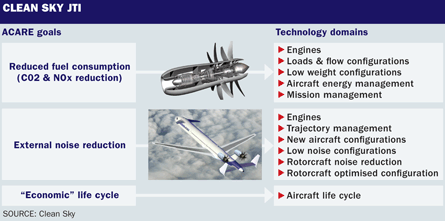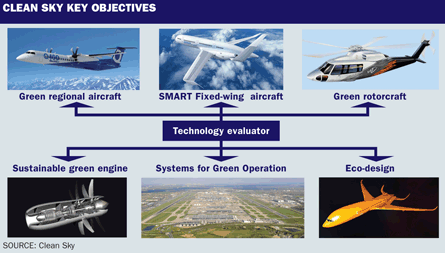By: Mike Scott
 |
|---|
© PhotolibraryClean Sky is targetting a 50% cut in CO2 and an 80% cut in NOx emissions by aircraft |
The €1.6 billion ($2.1 billion) Clean Sky joint venture between the European Commission and the European aviation industry has been beset by claims that it is too bureaucratic, which has slowed down the process of allocating research projects. But these problems are now largely solved, says Clean Sky chief executive Eric Dautriat.
"The 'starting' phase lasted until the end of [2009] because we had to put in place the resources for our members and deal with administrative issues, set up a legal framework and define how to implement proposals," he explains. "This joint technology initiative is a new framework.
"Red tape was a real issue and it took two years for the Joint Undertaking to become established. It was a time-consuming process, but the experience we have gained will help with future initiatives. It is not that surprising that when you put together a set of big industrial companies and the European Commission, it takes time to agree the rules."
The process is going fairly well, says Richard Oldfield, technical director at GKN Aerospace, but he adds: "It takes a huge amount of effort to bid for, and secure, work packages. They are split into reasonably small chunks, which adds bureaucracy and does not necessarily allow continuity in the programmes."
There are also intellectual property issues if work is started by one partner and then taken up by another company. "You are more likely to be selected for future tenders if you are already involved, but it does not take away the risk," says Oldfield. "We have concerns about bureaucracy on multiple levels and it is ongoing."
GKN has been successful in only about two-thirds of the projects it has bid for and the feedback is not always easy to understand, says Oldfield. But he stresses that Clean Sky represents a real opportunity to develop technology for the future. "The ambition is very high and that is great."
Clean Sky aims to "green" the aviation sector in line with the targets of the Advisory Council for Aeronautics Research in Europe (ACARE). These targets require the industry to cut carbon dioxide emissions by 50%, nitrogen oxide emissions by 80% and external noise by 50%.
The project is divided into six integrated technology demonstrators (ITD), with three platforms dedicated to different types of aircraft: the Smart Fixed Wing Aircraft ITD, led by Airbus and Saab, aims to provide solutions for large aircraft; Green Regional Aircraft, led by Alenia and EADS Casa, is aimed at the smaller jet market; and Green Rotorcraft, with Eurocopter and AgustaWestland at the helm, is focusing on the helicopter market.
There are also three "transverse" ITDs that have applications across all types of aircraft, including the Sustainable and Green Engines (SAGE) ITD, led by Rolls-Royce and Safran (Flight International, 5-11 October 2010). Systems for Green Operations, led by Liebherr and Thales, focuses on all-electrical aircraft equipment and systems architectures, thermal management, capabilities for green trajectories and improved ground operations to enable aircraft to fully exploit the benefits of the Single European Sky. The Eco-Design demonstrator, led by Dassault Aviation and Fraunhofer Gesellschaft, looks at the whole lifecycle of an aircraft, from drawing board to dismantling, and how to make it greener.
TECHNOLOGY EVALUATOR
All these different streams will be assessed in a Technology Evaluator that will analyse the performance of the technologies that emerge from Clean Sky against various operational scenarios and look at how they can be integrated into new aircraft.
With 2010 as the first "steady state" year of operation for Clean Sky, Dautriat says there have already been achievements. "We are now producing the first pieces of hardware and we have had some initial flight tests." These advances tend to be final demonstrations of technologies that pre-date the launch of the initiative, he adds. A number of measurement devices will be used in later demonstrations.
 |
|---|
In October, Airbus tested a novel acoustic protection of the air intake on an A380. "It's not the biggest achievement, but it's a sign that we are starting to deliver," says Dautriat.
In the Green Rotorcraft ITD, flight tests have started to improve knowledge of noise maps, enabling trajectories to be optimised, and the first tests of new composite materials for regional aircraft have taken place.
At a recent update on the progress of Clean Sky, Rocco Pinto of Alenia Aeronautica explained the aims of the Green Regional Aircraft ITD. "GRA will allow future regional aircraft to obtain weight reduction, aerodynamics efficiency and a higher level of operative performance," he said at the Institute of Mechanical Engineering in November. "To achieve these challenging results, the aircraft will be entirely revisited in all of its aspects."
The areas to be examined are low weight configuration, low noise configuration, all-electric aircraft, mission and trajectory management, and new configuration. The GRA ITD aims to cut emissions of both CO2 and NOx by one-tenth by reducing fuel burn and cutting drag. It also aims to reduce perceived noise outside the aircraft by 10dB.
The main aims of the helicopter initiative are to cut fuel consumption and emissions by developing a diesel-powered light helicopter and a craft with a turboshaft engine, says Sébastien Dubois, project officer for the Green Rotorcraft demonstrator. Other aims of the ITD are to cut noise by half and ensure compliance with the EU's Reach directive on chemicals.
Optimised configurations for noise reduction are due to be developed by early 2012, by which time there should also be a selection of breakthrough technologies and advanced configurations to affect rotorcraft noise reduction and greener operations. All these developments will be brought together, leading to flight tests and validation of technologies and configurations from mid-2014.
There has been progress on innovative rotor blades, drag reduction, a more electrical helicopter, lean powerplant, environment-friendly flightpath and eco-design, says Dubois. The diesel-powered light helicopter has the potential to save 30-40% of fuel consumption over the full flight envelope, he adds.
In the Sage (Sustainable and Green Engine) programme, three calls for proposals are due in 2011, in January, April and July, says Mark Pacey, programme manager at Rolls-Royce. These will cover requirements across Sage's five demonstrators, ranging from lean burn control system verification (Sage 1) to aero-engine intake acoustic liner technology development (Sage 3) and manufacturing composite oil tanks for turboshaft engines (Sage 5).
Meanwhile, the eco-design ITD has focused on new materials and processes, long-life structures and end-of-life solutions, looking at more than 150 technologies, says project officer Vittorio Selmin. Ground demonstrations are likely to start in 2013.
 |
|---|
In airframes, the ITD is looking for companies to help with development of emerging green technologies related to the production and dismantling of the aircraft. Examples include chromium-free dense and thin micro-arc coatings for corrosion protection of light alloys and production technologies related to magnesium-forming, as well as the customisation of lifecycle assessment tools for the aerospace industry. In systems, the focus is on developing methods and tools for thermal, electrical and energy transfer modelling, from component level up to aircraft level.
In the Systems for Green Operations ITD, the two main focuses are management of aircraft energy and management of trajectory and mission. The first strand concentrates on creating all-electric equipment system architectures that will allow a more fuel-efficient use of secondary power and thermal management that arises from this electrification. The second strand looks at how to reduce noise footprints by optimising trajectories and how to ensure the most fuel-efficient journey by avoiding weather hazards and adapting flight paths to local conditions.
In total, seven calls for proposals have been launched, at a rate of one every three months. The activities completed so far by members and partners represent about 15% of the total programme, says Dautriat.
Axel Krein, senior vice-president research and technology at Airbus, believes the real opportunity for Clean Sky is the ability to demonstrate new technologies, on the ground or in flight. "Large-scale demonstrations provide us with the information needed to manage the risk of introducing new technologies into an aircraft - demonstrations in real operational conditions," he says. "This requires long-term planning and the co-ordination of many R&T [research and technology] partners.
DETAILED PREPARATION
"Now, two and a half years into the seven-year programme, it is clear we are in the detailed preparation phase for these tests. After some challenges in the beginning, I think we are doing pretty well.
"For Airbus, Clean Sky is creating a lot of added value for research and technology. It is a very important programme to strengthen the European aeronautical industry and to boost the co-operation between all players and contributors preparing the technology for the next generation of commercial aircraft."
And although there are many different elements to the programme, says Krein, "Clean Sky is one project, rather than a fragmentation of individual pieces". He adds: "From the beginning, Clean Sky has been designed towards one common headline: 'The greening of the air transport system'. That means we encompass all the elements which together represent the European air transport system."
THE SME EXPERIENCE
One of Clean Sky's aims is to increase the number of small and medium-sized enterprises involved in the aviation industry, and so more than one-third of the topics - which are meant to contribute to the elaboration of the demonstrators - were won by SMEs.
"It has been beyond my expectations so far," says Clean Sky chief executive Eric Dautriat. Many of these SMEs are newcomers to the field of European research, and Dautriat adds: "These results show the ability of this Joint Technology Initiative to widen the basis of research and innovation. For SMEs, it can be a kind of stepping stone, allowing them to gain exposure to the European research framework."
One SME that has grabbed the opportunity to expand its reach in the sector is Cenaero, a Brussels-based research company that works on advanced simulation techniques. Its general manager, Michel Delanaye, says: "The interesting thing for us is the fact that we can expose our technology to companies and research centres that we would otherwise not be working with. It gives us access to new customers, broadens our network, and gives us the opportunity to offer our technology to major aerospace companies. It is a very good opportunity for networking and business development. It will help our business outside Clean Sky."
The process is relatively straightforward to get involved in, but is very competitive, he adds. "It is good because the major players get to work with new partners. I am sure they would like to work with their usual suppliers, but I think Clean Sky would lack something if that was the case. The European Commission is putting half the money in, so they have to demand some openness."
But Delanaye warns of the danger to the industry of focusing only on existing technologies rather than on future developments. "There is less money available for funding upstream research that will pay off in the future because so much money is going into Clean Sky," he says. "There is a danger that less progress is made in new developments in aerospace. It could injure the European industry's long-term competitiveness."
Source: Flight International























